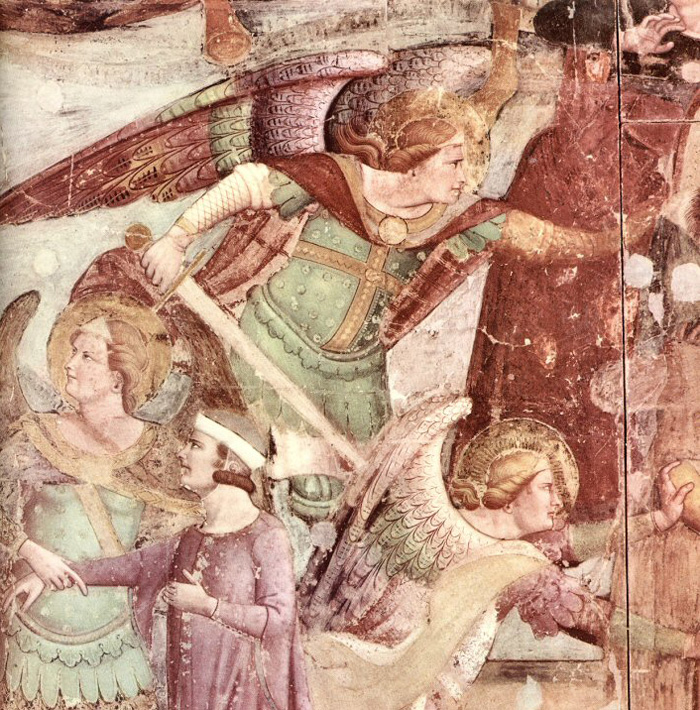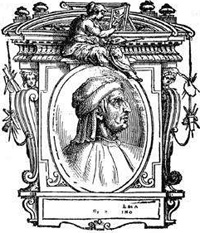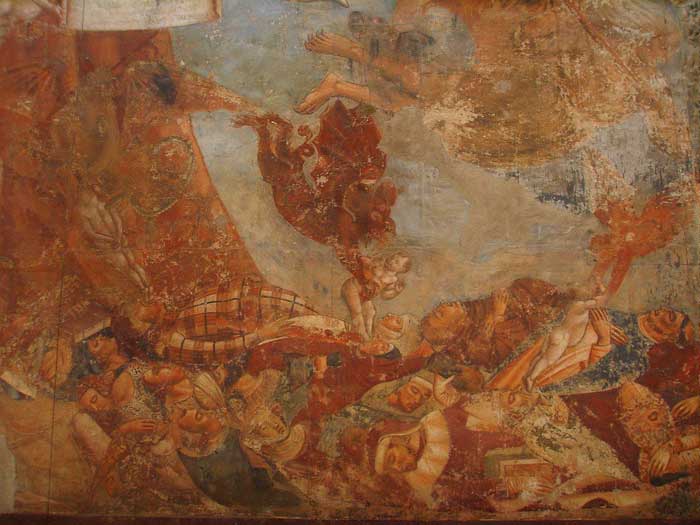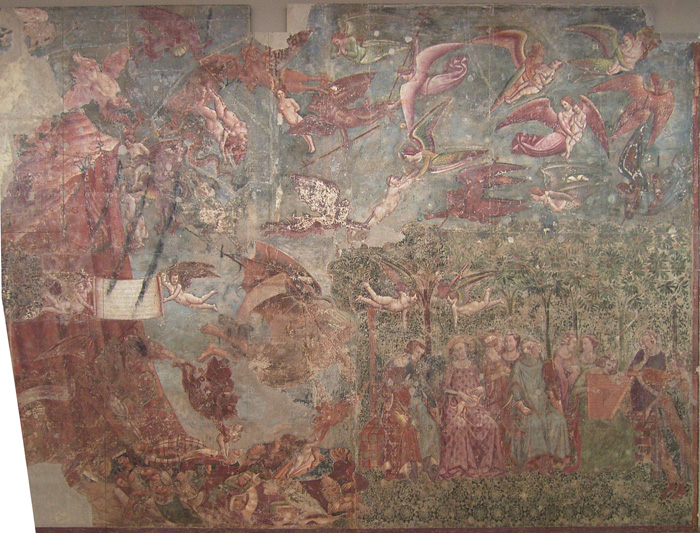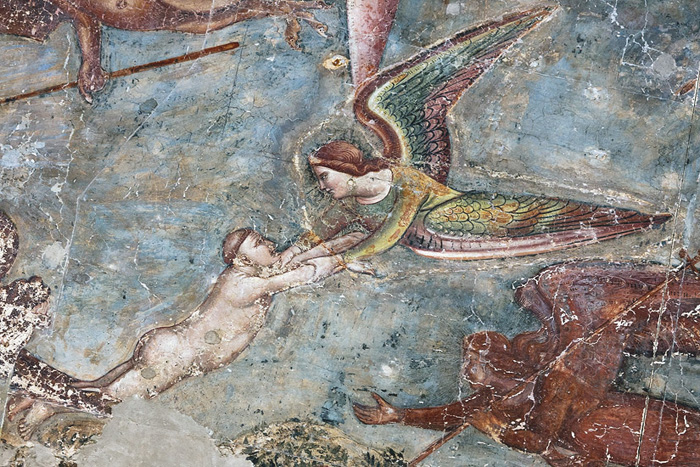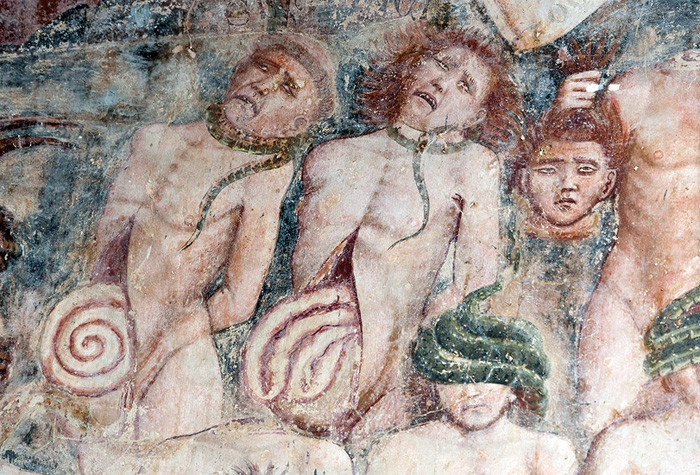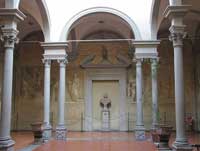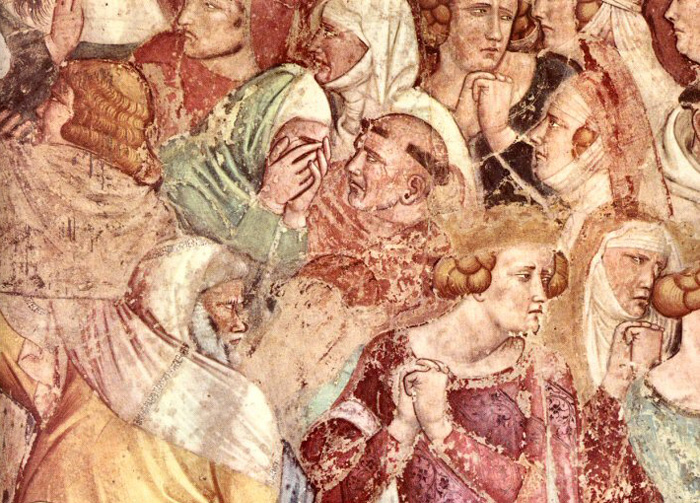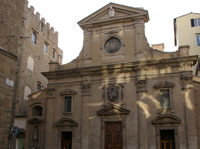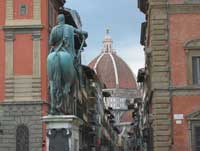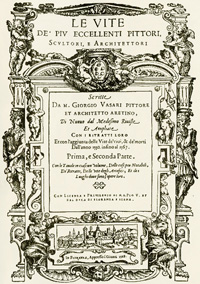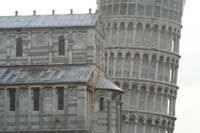| BUONAMICO DI CRISTOFANO, called Buffalmacco, painter of Florence, who was a disciple of Andrea Tafi, and celebrated for his jokes by Messer Giovanni Boccaccio in his Decameron, was, as is known, a very dear companion of Bruno and Calandrino, painters equally humorous and gay; and as may be seen in his works, scattered throughout all Tuscany, he was a man of passing good judgment in his art of painting. Franco Sacchetti relates in his three hundred Stories (to begin with the things that this man did while still youthful), that Buffalmacco lived, while he was a lad, with Andrea, and that this master of his used to make it a custom, when the nights were long, to get up before daylight to labor, and to call the lads to night work. This being displeasing to Buonamico, who was made to rise out of his soundest sleep, he began to think of finding a way whereby Andrea might give up rising so much before daylight to work, and he succeeded; for having found thirty large cockroaches, or rather blackbeetles, in a badly swept cellar, with certain fine and short needles he fixed a little taper on the back of each of the said cockroaches, and, the hour coming when Andrea was wont to rise, he lit the tapers and put the animals one by one into the room of Andrea, through a chink in the door.
He, awaking at the very hour when he was wont to call Buffalmacco, and seeing those little lights, all full of fear began to tremble and in great terror to recommend himself under his breath to God, like the old gaffer that he was, and to say his prayers or psalms; and finally, putting his head below the bedclothes, he made no attempt for that night to call Buffalmacco, but stayed as he was, ever trembling with fear, up to daylight. In the morning, then, having risen, he asked Buonamico if he had seen, as he had himself, more than a thousand demons; whereupon Buonamico said he had not, because he had kept his eyes closed, and was marvelling that he had not been called to night work. "To night work!" said Tafo, "I have had something else to think of besides painting, and I am resolved at all costs to go and live in another house." The following night, although Buonamico put only three of them into the said room of Tafo, none the less, what with terror of the past night and of those few devils that he saw, he slept not a wink; nay, no sooner was it daylight than he rushed from the house, meaning never to return, and a great business it was to make him change his mind.
At last Buonamico brought the parish priest, who consoled him the best that he could. Later, Tafo and Buonamico discoursing over the affair, Buonamico said: "I have ever heard tell that the greatest enemies of God are the demons, and that in consequence they must also be the most capital adversaries of painters; because, besides that we make them ever most hideous, what is worse, we never attend to aught else than to making saints, male and female, on walls and panels, and to making men more devout and more upright thereby, to the despite of the demons; wherefore, these demons having a grudge against us for this, as beings that have greater power by night than by day they come and play us these tricks, and worse tricks will they play if this use of rising for night work is not given up completely." With these and many other speeches Buffalmacco knew so well how to manage the business, being borne out by what Sir Priest kept saying, that Tafo gave over rising for night work, and the devils ceased going through the house at night with little lights. But Tafo beginning again, for the love of gain, not many months afterwards, having almost forgotten all fear, to rise once more to work in the night and to call Buffalmacco, the cockroaches too began again to wander about; wherefore he was forced by fear to give up the habit entirely, being above all advised to do this by the priest. Afterwards this affair, spreading throughout the city, brought it about that for a time neither Tafo nor other painters made a practice of rising to work at night. Later, and no long time after this, Buffalmacco, having become a passing good master, took leave of Tafo, as the same Franco relates, and began to work for himself; and he never lacked for something to do.
Now, Buffalmacco having taken a house, to work in and to live in as well, that had next door a passing rich woolworker, who, being a simpleton, was called Capodoca (Goosehead), the wife of this man would rise every night very early, precisely when Buffalmacco, having up to then been working, would go to lie down; and sitting at her wheel, which by misadventure she had planted opposite to the bed of Buffalmacco, she would spend the whole night spinning her thread; wherefore Buonamico, being able to get scarce a wink of sleep, began to think and think how he could remedy this nuisance. Nor was it long before he noticed that behind a wall of brickwork, that divided his house from Capodoca's, was the hearth of his uncomfortable neighbor, and that through a hole it was possible to see what she was doing over the fire. Having therefore thought of a new trick, he bored a hole with a long gimlet through a cane, and, watching for a moment when the wife of Capodoca was not at the fire, he pushed it more than once through the aforesaid hole in the wall and put as much salt as he wished into his neighbour's pot; wherefore Capodoca, returning either for dinner or for supper, more often than not could not eat or even taste either broth or meat, so bitter was everything through the great quantity of salt. For once or twice he had patience and only made a little noise about it; but after he saw that words were not enough, he gave blows many a time for this to the poor woman, who was in despair, it appearing to her that she was more than careful in salting her cooking. She, one time among others that her husband was beating her for this, began to try to excuse herself, wherefore Capodoca, falling into even greater rage, set himself to thrash her again in a manner that the woman screamed with all her might, and the whole neighborhood ran up at the noise; and among others there came up Buffalmacco, who, having heard of what Capodoca was accusing his wife and in what way she was excusing herself, said to Capodoca: "I' faith, comrade, this calls for a little reason; thou dost complain that the pot, morning and evening, is too much salted, and I marvel that this good woman of thine can do anything well. I, for my part, know not how, by day, she keeps on her feet, considering that the whole night she sits up over that wheel of hers, and sleeps not, to my belief, an hour. Make her give up this rising at midnight, and them wilt see that, having her fill of sleep, she will have her wits about her by day and will not fall into such blunders."
Then, turning to the other neighbors, he convinced them so well of the grave import of the matter, that they all said to Capodoca that Buonamico was speaking the truth and that it must be done as he advised. He, therefore, believing that it was so, commanded her not to rise in the night, and the pot was then reasonably salted, save when perchance the woman on occasion rose early, for then Buffalmacco would return to his remedy, which finally brought it about that Capodoca made her give it up completely. Buffalmacco, then, among the first works that he made, painted with his own hand the whole church of the Convent of the Nuns of Faenza, which stood in Florence on the site of the present Cittadella del Prato \; and among other scenes that he made there from the life of Christ, in all which he acquitted himself very well, he made the Massacre that Herod ordained of the Innocents, wherein he expressed very vividly the emotions both of the murderers and of the other figures ; for in some nurses and mothers who are snatching the infants from the hands of the murderers and are seeking all the assistance that they can from their hands, their nails, their teeth, and every movement of the body, there is shown on the surface a heart no less full of rage and fury than of woe.
Of this work, that convent being today in ruins, there is to be seen nothing but a colored sketch in our book of drawings by diverse masters, wherein there is this scene drawn by the hand of Buonamico. himself. In the doing of this work for the aforesaid Nuns of Faenza,. seeing that Buffalmacco was a person very eccentric and careless both in dress and in manner of life, it came to pass, since he did not always wear his cap and his mantle, as in those times it was the custom to do, that the nuns, seeing him once through the screen that he had caused to be made, began to say to the steward that it did not please them to see him. in that guise, in his jerkin; however, appeased by him, they stayed for a little without saying more. But at last, seeing him ever in the same guise, and doubting whether he was not some knavish boy for grinding colors, they had him told by the Abbess that they would have liked to see the master at work, and not always him. To which Buonamico answered, like the good fellow that he was, that as soon as the master was there, he would let them know; taking notice, none the less, of the little confidence that they had in him. Taking a stool, therefore, and placing another above it, he put on top of all a pitcher, or rather a water jar, and on the mouth of that he put a cap, hanging over the handle, and then he covered the rest of the jar with a burgher's mantle, and finally, putting a brush in suitable fashion into the spout through which the water is poured, he went off. The nuns, returning to see the work through an opening where the cloth had slipped, saw the supposititious master in full canonicals; wherefore, believing that he was working might and main and was by way of doing different work from that which the untidy knave was doing, they left it at that for some days, without thinking more about it.
Finally, having grown desirous to see what beautiful work the master had done, fifteen days having passed, during which space of time Buonamico had never come near the place, one night, thinking that the master was not there, they went to see his paintings, and remained all confused and blushing by reason of one bolder than the rest discovering the solemn master, who in fifteen days had done not one stroke of work. Then, recognizing that he had served them as they merited and that the works that he had made were worthy of nothing but praise, they bade the steward recall Buonamico, who, with the greatest laughter and delight, returned to the work, having given them to know what difference there is between men and pitchers, and that it is not always by their clothes that the works of men should be judged. In a few days, then, he finished a scene wherewith they were much contented, it appearing to them to be in every way satisfactory, except that the figures appeared to them rather wan and pallid than otherwise in the flesh-tints. Buonamico, hearing this, and having learnt that the Abbess had some Vernaccia, the best in Florence, which was used for the holy office of the Mass, said to them that in order to remedy this defect nothing else could be done but to temper the colours with some good Vernaccia; because, touching the cheeks and the rest of the flesh on the figures with colors thus tempered, they would become rosy and colored in most lifelike fashion. Hearing this, the good sisters, who believed it all, kept him ever afterwards furnished with the best Vernaccia, as long as the work lasted; and he, rejoicing in it, from that time onwards made the figures fresher and more highly colored with his ordinary colors!
This work finished, he painted some stories of S. James in the Abbey of Settimo, in the chapel that is in the cloister, and dedicated to that Saint, on the vaulting of which he made the four Patriarchs and the four Evangelists, among whom S. Luke is doing a striking action in blowing very naturally on his pen, in order that it may yield its ink. Next, in the scenes on the walls, which are five, there are seen beautiful attitudes in the figures, and the whole work is executed with invention and judgment. And because Buonamico was wont, in order to make his flesh color better, as is seen in this work, to make a ground of purple, which in time produces a salt that becomes corroded and eats away the white and other colors, it is no marvel if this work is spoilt and eaten away, whereas many others that were made long before have been very well preserved. And I, who thought formerly that these pictures had received injury from the damp, have since proved by experience, studying other works of the same man, that it is not from the damp but from this particular use of Buffalmacco's that they have become spoilt so completely that there is not seen in them either design or anything else, and that where the flesh colors were there has remained nothing else but the purple. This method of working should be used by no one who is anxious that his pictures should have long life.
Buonamico wrought, after that which has been described above, two panels in distemper for the Monks of the Certosa of Florence, whereof one is where the books of chants are kept for the use of the choir, and the other below in the old chapels. He painted in fresco the Chapel of the Giochi and Bastari in the Badia of Florence, beside the principal chapel; which chapel, although afterwards it was conceded to the family of the Boscoli, retains the said pictures of Buffalmacco up to our own day. In these he made the Passion of Christ, with effects ingenious and beautiful, showing very great humility and sweetness in Christ, who is washing the feet of His Disciples, and ferocity and cruelty in the Jews, who are leading Him to Herod. But he showed talent and facility more particularly in a Filate, whom he painted in prison, and in Judas hanging from a tree; wherefore it is easy to believe what is told about this gay painter namely, that when he thought fit to use diligence and to take pains, which rarely came to pass, he was not inferior to any painter whatsoever of his times. And to show that this is true, the works injresco that he made in Ognissanti, where today there is the cemetery, were wrought with so much diligence and with so many precautions, that the water which has rained over them for so many years has not been able to spoil them or to prevent their excellence from being recognized, and that they have been preserved very well, because they were wrought purely on the fresh plaster. On the walls, then, are the Nativity of Jesus Christ and the Adoration of the Magi that is, over the tomb of the Aliotti. After this work Buonamico, having gone to Bologna, wrought some scenes in fresco in S. Petronio, in the Chapel of the Bolognini that is, on the vaulting; but by reason of some accident, I know not what, supervening, he did not finish them.
It is said that in the year 1302 he was summoned to Assisi, and that in the Church of S. Francesco, in the Chapel of S. Caterina, he painted all the stories of her life in fresco, which have been very well preserved; and there are therein some figures that are worthy to be praised. This chapel finished, on his passing through Arezzo, Bishop Guido, by reason of having heard that Buonamico was a gay fellow and an able painter, desired him to stop in that city and paint for him, in the Vescovado, the chapel where baptisms are now held. Buonamico, having put his hand to the work, had already done a good part of it when there befell him the strangest experience in the world, which was, according to what Franco Sacchetti relates, as follows. The Bishop had an ape, the drollest and the most mischievous that there had ever been. This animal, standing once on the scaffolding to watch Buonamico at work, had given attention to everything, and had never taken his eyes off him when he was mixing the colors, handling the flasks, beating the eggs for making the distempers, and in short when he was doing anything else whatsoever.
Now, Buonamico having left off working one Saturday evening, on the Sunday morning this ape, notwithstanding that he had, fastened to his feet, a great block of wood which the Bishop made him carry in order that thus he might not be able to leap wherever he liked, climbed on to the scaffolding whereon Buonamico was used to stand to work, in spite of the very great weight of the block of wood; and there, seizing the flasks with his hands, pouring them one into another and making six mixtures, and beating up whatever eggs there were, he began to daub over with the brushes all the figures there, and, persevering in this performance, did not cease until he had repainted everything with his own hand; and this done, he again made a mixture of all the colors that were left him, although they were but few, and, getting down from the scaffolding, went off. Monday morning having come, Buonamico returned to his work, where, seeing the figures spoilt, the flasks all mixed up, and everything upside down, he stood all in marvel and confusion. Then, having pondered much in his own mind, he concluded finally that some Aretine had done this, through envy or through some other reason; wherefore, having gone to the Bishop, he told him how the matter stood and what he suspected, whereat the Bishop became very much disturbed, but, consoling Buonamico, desired him to put his hand again to the work and to repaint all that was spoilt. And because the Bishop had put faith in his words, which had something of the probable, he gave him six of his men-at-arms, who should stand in hiding with halberds while he was not at work, and, if anyone came, should cut him to pieces without mercy.
The figures, then, having been painted over again, one day that the soldiers were in hiding, lo and behold! they hear a certain rumbling through the church, and a little while after the ape climbing on to the scaffolding; and in the twinkling of an eye, the mixtures made, they see the new master set himself to work over the saints of Buonamico. Calling him, therefore, and showing him the culprit, and standing with him to watch the beast at his work, they were all like to burst with laughter; and Buonamico in particular, for all that he was vexed thereby, could not keep from laughing till the tears came. Finally, dismissing the soldiers who had mounted guard with their halberds, he went off to the Bishop and said to him: " My lord, you wish the painting to be done in one fashion, and your ape wishes it done in another." Then, relating the affair, he added: "There was no need for you to send for painters from elsewhere, if you had the true master at home. But he, perhaps, knew not so well how to make the mixtures; now that he knows, let him do it by himself, since I am no more good here. And his talent being revealed, I am content that there should be nothing given to me for my work save leave to return to Florence." The Bishop, hearing the affair, although it vexed him, could not keep from laughing, and above all as he thought how an animal had played a trick on him who was the greatest trickster in the world. However, after they had talked and laughed their fill over this strange incident, the Bishop persuaded Buonamico to resume the work for the third time, and he finished it. And the ape, as punishment and penance for the crime committed, was shut up in a great wooden cage and kept where Buonamico was working, until this work was entirely finished; and no one could imagine the contortions which that creature kept making in this cage with his face, his body, and his hands, seeing others working and himself unable to take part.
The work in this chapel finished, the Bishop, either in jest or for some other reason known only to himself, commanded that Buffalmacco should paint him, on one wall of his palace, an eagle on the back of a lion which it had killed. The crafty painter, having promised to do all that the Bishop wished, had a good scaffolding made of planks, saying that he refused to be seen painting such a thing. This made, shutting himself up alone inside it, he painted, contrary to what the Bishop wished, a lion that was tearing to pieces an eagle ; and, the work finished, he sought leave from the Bishop to go to Florence in order to get some colors that he was wanting. And so, locking the scaffolding with a key, he went off to Florence, in mind to return no more to the Bishop, who, seeing the business dragging on and the painter not returning, had the scaffolding opened, and discovered that Buonamico had been too much for him. Wherefore, moved by very great displeasure, he had him banished on pain of death, and Buonamico, hearing this, sent to tell him to do his worst; whereupon the Bishop threatened him to a fearful tune. But finally, remembering that he had begun the playing of tricks and that it served him right to be tricked himself, he pardoned Buonamico for his insult and rewarded him liberally for his labors. Nay, what is more, summoning him again no long time after to Arezzo, he caused him to make many works in the Duomo Vecchio, which are now destroyed, treating him ever as his familiar friend and very faithful servant. The same man painted the niche of the principal chapel in the Church of S. Giustino, also in Arezzo.
Some writers tell that Buonamico being in Florence and often frequenting the shop of Maso del Saggio with his friends and companions, he was there, with many others, arranging the festival which the men of the Borgo San Friano held on May 1 in certain boats on the Arno; and that when the Ponte alia Carraia, which was then of wood, collapsed by reason of the too great weight of the people who had flocked to that spectacle, he did not die there, as many others did, because, precisely at the moment when the bridge collapsed on to the structure that was representing Hell on the boats in the Arno, he had gone to get some things that were wanting for the festival.
Being summoned to Pisa no long time after these events, Buonamico painted many stories of the Old Testament in the Abbey of S. Paolo a Ripa d'Arno, then belonging to the Monks of Vallombrosa, in both tran- septs of the church, on three sides, and from the roof down to the floor, beginning with the Creation of man, and continuing up to the completion of the Tower of Nimrod. In this work, although it is today for the greater part spoilt, there are seen vivacity in the figures, good skill and loveliness in the coloring, and signs to show that the hand of Buonamico could very well express the conceptions of his mind, although he had little power of design. On the wall of the right transept which is opposite to that wherein is the side door, in some stories of S. Anastasia, there are seen certain ancient costumes and headdresses, very charming and beautiful, in some women who are painted there with graceful manner. Not less beautiful, also, are those figures that are in a boat, with well-conceived attitudes, among which is the portrait of Pope Alexander IV, which Buonamico had, so it is said, from Tafo his master, who had portrayed that Pontiff in mosaic in S. Pietro. In the last scene, likewise, wherein is the martyrdom of that Saint and of others, Buonamico expressed very well in the faces the fear of death and the grief and terror of those who are standing to see her tortured and put to death, while she stands bound to a tree and over the fire.
A companion of Buonamico in this work was Bruno di Giovanni, a painter, who is thus called in the old book of the Company; which Bruno (also celebrated as a gay fellow by Boccaccio), the said scenes on the walls being finished, painted the altar of S. Ursula with the company of virgins in the same church. He made in one hand of the said Saint a standard with the arms of Pisa, which are a white cross on a field of red, and he made her offering the other hand to a woman who, rising between two mountains and touching the sea with one of her feet, is stretching both her hands to her in the act of supplication ; which woman, representing Pisa, and having on her head a crown of gold and over her shoulders a mantle covered with circlets and eagles, is seeking assistance from that Saint, being much in travail in the sea. Now, for the reason that in painting this work Bruno was bewailing that the figures which he was making therein had not the same life as those of Buonamico, the latter, in his waggish way, in order to teach him to make his figures not merely vivacious but actually speaking, made him paint some words issuing from the mouth of that woman who is supplicating the Saint, and the answer of the Saint to her, a device that Buonamico had seen in the works that had been made in the same city by Cimabue. This expedient, even as it pleased Bruno and the other thick-witted men of those times, in like manner pleases certain boors today, who are served therein by craftsmen as vulgar as themselves. And in truth it seems extraordinary that from this beginning there should have passed into use a device that was employed for a jest and for no other reason, inso- much that even a great part of the Campo Santo, wrought by masters of repute, is full of this rubbish.
The works of Buonamico, then, finding much favor with the Pisans, he was charged by the Warden of the Works of the Campo Santo to make four scenes in fresco, from the beginning of the world up to the construction of Noah's Ark, and round the scenes an ornamental border, wherein he made his own portrait from the life namely, in a frieze, in the middle of which, and on the corners, are some heads, among which, as I have said, is seen his own, with a cap exactly like the one that is seen above. And because in this work there is a God, who is upholding with his arms the heavens and the elements nay, the whole body of the universe Buonamico, in order to explain his story with verses similar to the pictures of that age, wrote this sonnet in capital letters at the foot, with his own hand, as may still be seen; which sonnet, by reason of its antiquity and of the simplicity of the language of those times, it has seemed good to me to include in this place, although in my opinion it is not likely to give much pleasure, save perchance as something that bears witness as to what was the knowledge of the men of that century:
Voi che avisate questa dipintura
Di Dio pietoso, sommo creatore,
Lo qual fe' tutte cose con amore,
Pesate, numerate ed in misura;
In nove gradi angelica natura,
In ello empirio ciel pien di splendore,
Colui che non si muove ed e motore,
Ciascuna cosa fece buona e pura.
Levate gli occhi del vostro intelletto,
Considerate quanto e ordinato
Lo mondo universale; e con affetto
Lodate lui che 1' ha si ben create;
Pensate di passare a tal diletto
Tra gli Angeli, dov' e ciascun beato.
Per questo mondo si vede la gloria,
Lo basso e il mezzo e 1' alto in questa storia.
And to tell the truth, it was very courageous in Buonamico to undertake to make a God the Father five braccia high, with the hierarchies, the heavens, the angels, the zodiac, and all the things above, even to the heavenly body of the moon, and then the element of fire, the air, the earth, and finally the nether regions ; and to fill up the two angles below he made in one, S. Augustine, and in the other, S. Thomas Aquinas. At the head of the same Campo Santo, where there is now the marble tomb of Corte, Buonamico painted the whole Passion of Christ, with a great number of figures on foot and on horseback, and all in varied and beautiful attitudes; and continuing the story he made the Resurrection and the Apparition of Christ to the Apostles, passing well. Having finished these works and at the same time all that he had gained ^Pisa, which was not little, he returned to Florence as poor as he had left it, and there he made many panels and works in fresco, whereof there is no need to make further record. Meanwhile there had been entrusted to Bruno, his great friend (who had returned with him from Pisa, where they had squandered everything), some works in S. Maria Novella, and seeing that Bruno had not much design or invention, Buonamico designed for him all that he afterwards put into execution on a wall in the said church, opposite to the pulpit and as long as the space between column and column, and that was the story of S. Maurice and his companions, who were beheaded for the faith of Jesus Christ. This work Bruno made for Guido Campese, then Constable of the Florentines, whose portrait he had made before he died in the year 1312; in that work he painted him in his armour, as was the custom in those times, and behind him he made a line of men-at-arms, armed in ancient fashion, who make a beautiful effect, while Guido himself is kneeling before a Madonna who has the Child Jesus in her arms, and is appearing to be recommended to her by S. Dominic and S. Agnes, who are on either side of him. Although this picture is not very beautiful, yet, considering the design and invention of Buonamico, it is worthy to be in part praised, and above all by reason of the costumes, helmets, and other armor of those times. And I have availed myself of it in some scenes that I have made for the Lord Duke Cosimo, wherein it was necessary to represent men armed in ancient fashion, and other similar things of that age; which work has greatly pleased his most Illustrious Excellency and others who have seen it. And from this it can be seen how much benefit may be gained) from the inventions and works made by these ancients, although they I may not be very perfect, and in what fashion profit and advantage can// be drawn from their performances, since they opened the way for us tto the marvels that have been made up to our day and are being made continually.
While Bruno was making this work, a peasant desiring that Buonamico should make him a S. Christopher, they came to an agreement in Florence and arranged a contract in this fashion, that the price should be eight florins and that the figure should be twelve braccia high. Buonamico, then, having gone to the church where he was to make the S. Christopher, found that by reason of its not being more than nine braccia either in height or in length, he could not, either without or within, accommodate the figure in a manner that it might stand well; wherefore he made up his mind, since it would not go in upright, to make it within the church lying down. But since, even so, the whole length would not go in, he was forced to bend it from the knees downwards on to the wall at the head of the church. The work finished, the peasant would by no means pay for it; nay, he made an outcry and said he had been cozened. The matter, therefore, going before the Justices, it was judged, according to the contract, that Buonamico was in the right.
In S. Giovanni fra I'Arcore was a very beautiful Passion of Christ by the hand of Buonamico, and among other things that were much praised therein was a Judas hanging from a tree, made with much judgment and beautiful manner. An old man, likewise, who was blowing his nose, was most natural, and the Maries, broken with weeping, had expressions and aspects so sad, that they deserved to be greatly praised, since that age had not as yet much facility in the method of representing V the emotions of the soul with the brush. On the same wall there was a good figure in a S. Ivo of Brittany, who had many widows and orphans at his feet, and two angels in the sky, who were crowning him, were made with the sweetest manner. This edifice and the pictures together were thrown to the ground in the year of the war of 1529.
In Cortona. also, for Messer Aldobrandino, Bishop of that city, Buonamico painted many works in the Vescovado, and in particular the chapel and panel of the high altar; but seeing that everything was thrown to the ground in renovating the palace and the church, there is no need to make further mention of them. In S. Francesco, however, and in S. Margherita, in the same city, there are still some pictures by the hand of Buonamico. From Cortona going once more to Assisi, Buonamico painted in fresco, in the lower Church of S. Francesco, the whole Chapel of Cardinal Egidio Alvaro, a Spaniard; and because he acquitted himself very well, he was therefore liberally rewarded by that Cardinal. Finally, Buonamico having wrought many pictures throughout the whole March, in returning to Florence he stopped at Perugia, and painted there in fresco the Chapel of the Buontempi in the Church of S. Domenico, making therein stories of the life of S. Catherine, virgin and martyr. And in the Church of S. Domenico Vecchio, on one wall, he painted in fresco the scene when the same Catherine, daughter of King Costa, making disputation, is convincing and converting certain philosophers to the faith of Christ; and seeing that this scene is more beautiful than any other that Buonamico ever made, it can be said with truth that in this work he surpassed himself. The people of Perugia, moved by this, according to what Franco Sacchetti writes, commanded that he should paint S. Ercolano, Bishop and Protector of that city, in the square ; wherefore, having agreed about the price, on the spot where the painting was to be done there was made a screen of planks and matting, to the end that the master might not be seen painting; and this made, he put his hand to the work.
But before ten days had passed, every passer-by asking when this picture would be finished, as though such works were cast in moulds, [* Proverbial expression, equivalent to our "twinkling of an eye."] the matter disgusted Buonamico; wherefore, having come to the end of the work and being distracted with such importunity, he determined within himself to take a gentle vengeance on the impatience of these people. And this came to pass, for, when the work was finished, before unveiling it, he let them see it, and it was entirely to their satisfaction; but on the people of Perugia wishing to remove the screen at once, Buonamico said that for two days longer they should leave it standing, for the reason that he wished to retouch certain parts on the dry; and so it was done. Buonamico, then, having mounted the scaffolding, removed the great diadem of gold that he had given to the Saint, raised in relief with plaster, as was the custom in those times, and made him a crown, or rather garland, right round his head, of roaches; and this done, one morning he settled with his host and went off to Florence. Now, two days having passed, the people of Perugia, not seeing the painter going about as they had been used, asked the host what had become of him, and, hearing that he had returned to Florence, went at once to remove the screen; and finding their S. Ercolano crowned solemnly with roaches, they sent word of it immediately to their governors. But although these sent horsemen post-haste to look for Buonamico, it was all in vain, seeing that he had returned in great haste to Florence. Having determined, then, to make a painter of their own remove the crown of roaches and restore the diadem to the Saint, they said all the evil that can be imagined about Buonamico and the rest of the Florentines.
Buonamico, back in Florence and caring little about what the people of Perugia might say, set to work and made many paintings, whereof, in order not to be too long, there is no need to make mention. (I will say only this, that having painted in fresco at Calcinaia a Madonna with the Child in her arms, he who had charged him to do it, in place of paying him, gave him words; whence Buonamico, who was not used to being trifled with or being fooled, determined to get his due by hook or by crook. And so, having gone one morning to Calcinaia, he transformed the child that he had painted in the arms of the Virgin into a little bear, but in colors made only with water, without size or distemper. This change being seen, not long after, by the peasant who had given him the work to do, almost in despair he went to find Buonamico, praying him for the sake of Heaven to remove the little bear and to paint another child as before, for he was ready to make satis- faction. This the other did amicably, being paid for both the first and the second labour without delay; and for restoring the whole work a wet sponge sufficed. Finally, seeing that it would take too long were I to wish to relate all the tricks, as well as all the pictures, that Buonamico Buffalmacco made, and above all when frequenting the shop of Maso del Saggio, which was the resort of citizens and of all the gay and mischievous spirits that there were in Florence, I will make an end of discoursing about him.
He died at the age of seventy-eight, and being very poor and having done more spending than earning, by reason of being such in character, he was supported in his illness by the Company of the Misericordia in S. Maria Nuova, the hospital of Florence; and then, being dead, he was buried in the Ossa (for so they call a cloister, or rather cemetery, of the hospital), like the rest of the poor, in the year 1340. The works of this man were prized while he lived, and since then, for works of that age, they have been ever extolled.
|
|
|
